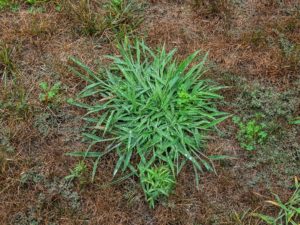
Learn what you can do to prevent and remove crabgrass from your landscape.
Lush, green lawns are what every homeowner dreams of for the summer. Unfortunately, if you did not apply a pre-emergent herbicide in the spring, your lawn is susceptible to the germination of crabgrass. While it is preferable to stop crabgrass before it germinates, if it emerges on your lawn this summer, you can take a few steps to eliminate it, so you don’t have to spend months with a less-than-beautiful yard. Read on to learn more about how to spot and remove crabgrass carefully without hurting the rest of your lawn.
What Does Crabgrass Look Like?
Crabgrass is noticeable as a coarse, clumpy weed that looks like yellow or light-green grass blades. It is unattractive and unsightly, but more crucially, it is bad for your lawn’s health. This is because crabgrass can crowd out turf and make it difficult for healthy turfgrass to grow. The weed outcompetes turfgrass for limited nutrients. Unlike perennial weeds, crabgrass is an annual weed and only lives one year. They are killed when the first frost arrives in fall. By that time, crabgrass has matured and produced seed for next year. When the first frost kills crabgrass patches, it leaves unsightly brown patches of dead grass.
What Does Crabgrass Do?
Although they germinate, live, and die in one year, crabgrass plants produce up to 150,000 seeds while they live. Those seeds stay behind, ready to germinate in the following spring and start the cycle again. Effective control with pre-emergent crabgrass control is required to prevent these seeds from ever becoming seed-producing plants.
How to Remove Crabgrass With a Pre-Emergent
The key to preventing those seeds from germinating is using a pre-emergent herbicide. If you want to wait out the summer, the crabgrass currently on your lawn will die in the fall. You can then apply a pre-emergent next spring to prevent germination in the summer.
Alternatively, you can remove crabgrass infestations by hand then follow it up with healthy lawn care habits. For example, you can:
- Pull the crabgrass up, roots and all. If it’s difficult, you can water the lawn to loosen the soil.
- Seed the lawn to fill bare areas. If you recently used weed killer, wait a month before reseeding.
- Water your lawn deeply when the soil is dry.
- When mowing, keep the grass about three inches tall. Then, leave grass clippings behind to provide natural nutrients.
- Next spring, apply a pre-emergent herbicide around the time that your flowers and trees start to bloom, usually by April 15 in our area. Some pre-emergents also have post-emergence activity on young crabgrass plants and can be used after April 15.
Pre-emergents work by inhibiting seed germination and root development so that seeds cannot become plants. However, if you are unfamiliar with herbicides, you should contact the experts at Scientific Plant Service to make sure you apply the pre-emergent effectively to the crabgrass seeds without harming the rest of your lawn.
When to Use Post-Emergent Herbicides
Once seeds germinate and crabgrass seedlings emerge, most pre-emergents are no longer effective. To remove crabgrass, you will have to use post-emergent herbicides that target plants instead of seeds.
It is best to work with an expert when using post-emergents. You want to make sure that you use the correct type of herbicide at the proper rate for effective crabgrass control.
If crabgrass is taking control of your lawn, it’s never too late to do something about it.
Scientific Plant Service Is Your Go-To Source In Landscape Healthcare
Scientific Plant Service, located in Baltimore, is a privately owned corporation, chartered in Maryland in 1957 by Frank J. Burke. We started as a full-service Arborists specializing in the care of shade trees and ornamental shrubs, but today we are a Lawn Care company that is a huge part of the community. From aquatic environments and snow management to deer and mole control, SPS has services tailored specifically for your lawn and landscape.
We offer services in Maryland, Washington, DC, and Virginia, including: Harford, Baltimore, Carroll, Frederick, Howard, Anne Arundel, Montgomery, Prince Georges, Talbot, Queen Anne’s, Calvert counties in MD, as well as Loudoun County, Fairfax County, Arlington, Alexandria, and Falls Church in VA. For more information, contact us online, or call us at 410-321-0970. Be sure to follow us on Facebook, Twitter, LinkedIn, and Pinterest!

